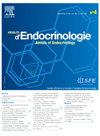雄激素在生育前调节卵巢功能的作用
IF 2.9
3区 医学
Q3 ENDOCRINOLOGY & METABOLISM
引用次数: 0
摘要
目的在女性中,雄激素是多囊卵巢综合征(PCOS)等卵巢疾病的诱因,但雄激素也是卵巢生理功能的关键,即在生殖期与 LH 和 FSH 相互作用,促进卵泡生长和性类固醇合成。然而,雄激素在生育前是否在卵巢中发挥作用尚不清楚。事实上,卵泡的生长和性类固醇的合成早在生殖期之前就开始了,尤其是在出生后的小青春期(minipuberty),其特点是促性腺激素水平较高。因此,我们以小鼠为实验模型,分析了雄激素在卵巢内的作用及其与促性腺激素之间可能存在的相互作用。结果 未成年卵巢产生大量睾酮,并在生长的卵泡中显示雄激素受体(AR)的表达,两者均受 LH 控制。通过在体内或卵巢培养物中阻断雄激素信号传导,我们发现这一途径可能通过介导卵巢内一些关键调节因子的表达参与雌二醇合成和卵泡生长的调节,这些调节因子包括FSH受体、将雄激素转化为雌激素的芳香化酶(Cyp19a1)和细胞周期抑制剂p27KIP1。讨论这项工作表明,雄激素信号在小青春期卵巢中已经激活,与促性腺激素信号相互作用,调节卵巢的关键过程。我们认为,小青春期雄激素在卵巢中发挥着重要的生理作用,并进而影响未来的生殖功能。本文章由计算机程序翻译,如有差异,请以英文原文为准。
Androgens in the regulation of ovarian function before reproductive life
Objectives
In females, androgens contribute to ovarian diseases such as polycystic ovarian syndrome (PCOS), but they are key for ovarian physiology, i.e., follicular growth and sex steroid synthesis during reproductive life in interaction with LH and FSH. However, it is unclear whether androgens play a role in the ovary before reproductive life. Indeed, follicular growth and sex steroid synthesis begin well before reproductive life and are particularly active after birth, during a transient phase called minipuberty characterized by high levels of gonadotropins. Therefore, we analyzed the intra-ovarian actions of androgens and their possible interaction with gonadotropins during minipuberty, using the mouse as an experimental model.
Methods
We used biochemical- and molecular-based studies and pharmacological approaches in vivo and on cultured ovaries.
Results
Minipubertal ovaries produce significant amounts of testosterone and display androgen receptor (AR) expression in growing follicles, both under the control of LH. By blocking androgen signaling either in vivo or in ovarian cultures, we found that this pathway may participate in the regulation of estradiol synthesis and follicular growth by mediating the expression of a number of key intra-ovarian regulators, including FSH receptor, the aromatase enzyme converting androgens into estrogens (Cyp19a1) and the cell cycle inhibitor p27KIP1.
Discussion
This work suggests that androgens signaling is already activated in mini-pubertal ovaries to regulate key ovarian processes, at the interplay with gonadotropin signaling. We propose that mini-pubertal androgens play an important physiological role in the ovary, and by extension, in future reproductive function.
求助全文
通过发布文献求助,成功后即可免费获取论文全文。
去求助
来源期刊

Annales d'endocrinologie
医学-内分泌学与代谢
CiteScore
4.40
自引率
6.50%
发文量
311
审稿时长
50 days
期刊介绍:
The Annales d''Endocrinologie, mouthpiece of the French Society of Endocrinology (SFE), publishes reviews, articles and case reports coming from clinical, therapeutic and fundamental research in endocrinology and metabolic diseases. Every year, it carries a position paper by a work-group of French-language endocrinologists, on an endocrine pathology chosen by the Society''s Scientific Committee. The journal is also the organ of the Society''s annual Congress, publishing a summary of the symposia, presentations and posters. "Les Must de l''Endocrinologie" is a special booklet brought out for the Congress, with summary articles that are always very well received. And finally, we publish the high-level instructional courses delivered during the Henri-Pierre Klotz International Endocrinology Days. The Annales is a window on the world, keeping alert clinicians up to date on what is going on in diagnosis and treatment in all the areas of our specialty.
 求助内容:
求助内容: 应助结果提醒方式:
应助结果提醒方式:


